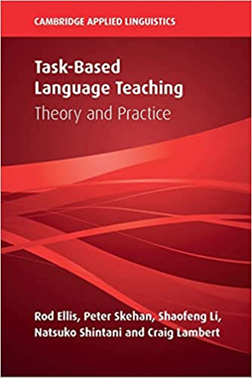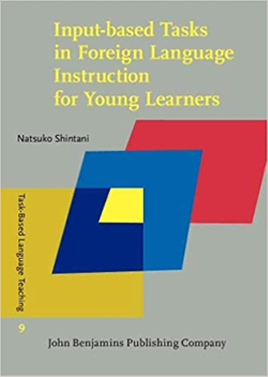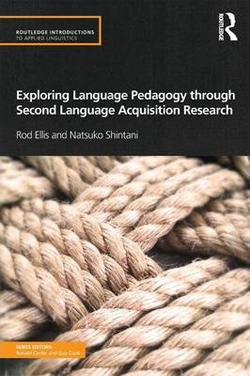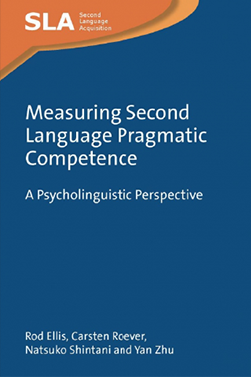- Books
- Edited volumes
- Articles in refereed international journals
- Book Chapters/ Encyclopedia entries
- Publications in Japan
Books
Ellis, R., Skehan, P., Li, S., Shintani, N., & Lambert, C. (2019).
Task-based language teaching: Theory and practice. Cambridge University Press.

Shintani, N. (2016).
The role of input-based tasks in foreign
language instruction for young learners. John Benjamins.

Ellis, R. & Shintani, N. (2014). Exploring language pedagogy through second language acquisition research. Routledge.

Ellis, R., Roever, C., Shintani, N., & Zhu, Yan. (2024). Measuring second language pragmatic competence: A psycholinguistic perspective. Multilingual Matters.

Edited volumes
Li, S., Shintani, N., & Ellis, R. (Eds.). (2015). Synthesizing research in applied linguistics: the complementary contributions of narrative reviews and meta-analyses, Special Issue of Applied Linguistics, 36(3).
Articles in refereed international journals
Tchesa, G. & Shintani, N. (2024). Effects of Declarative and Procedural Memory in the Development of Grammatical Structures: A Cross-Sectional Study. Language Matters 55(1).
Mizumoto, A., Shintani, N., Sasaki, M., & Teng, M. F. (2024). Testing the viability of ChatGPT as a companion in L2 writing accuracy assessment. Research Methods in Applied Linguistics, 3(2), 100116.
Ellis, R. & Shintani, N. (2023). Investigating a failed novel test of socio-pragmatic knowledge. Research Methods in Applied Linguistics 2(1), 100046.
Shintani, N. & Ellis, R. (2022). The roles of language proficiency and study abroad in Japanese students’ receptive pragmatic competence. Applied Pragmatics 4(1), 1–32.
Ellis, R., Zhu, Y., Shintani, N., & Roever, C. (2021). A study of Chinese learners’ ability to comprehend irony. Journal of Pragmatics 172, 7–20.
Wong, S. & Shintani, N. (2021). Computer-mediated instruction using ondoku practice for developing elementary school students’ pronunciation skills. Language Teaching for Young Learners 3(1), 161–175.
Shintani, N. (2019). Potentials of writing-to-learn-language activities from second language acquisition research. Journal of Second Language Writing 46.
Shintani, N., Saito, K., & Koizumi, R. (2019). The relationship between raters’ multilingual background and their perceptions of accentedness and comprehensibility of second language speech. International Journal of Bilingual Education and Bilingualism 22(7), 849–869.
Yang, Y., Shintani, N., Li, S., & Zhang, Y. (2017). The effectiveness of post-reading word-focused activities and their associations with working memory. System 70, 38–49.
Shintani, N. (2017). The effects of the timing of isolated FFI on the explicit knowledge and written accuracy of learners with different prior knowledge of the linguistic target. Studies in Second Language Acquisition 39(1), 129–166.
Saito & Shintani (2016). Foreign accentedness revisited: Canadian and Singaporean raters’ perception of Japanese-accented English. Language Awareness 25(4), 305–317.
Shintani, N., Aubrey, S., & Donnellan, M. (2016). The effects of pre-task and post-task metalinguistic explanations on accuracy in seond language writing. TESOL Quarterly 50(4), 945–955.
Shintani, N. & Aubrey, S. (2016). The effectiveness of synchronous and asynchronous written corrective feedback on grammatical accuracy in a computer-mediated environment. The Modern Language Journal 100(1), 296–319.
Shintani, N. (2016). Computer-mediated synchronous and asynchronous direct corrective feedback on writing: A case study. Computer Assisted Language Learning 29(3), 517–538.
Saito, K. & Shintani, N. (2016). Perceived comprehensibility in second language speech: comparisons of native speaking raters in Canada and Singapore. TESOL Quarterly 50(2), 421–446.
Shintani, N. (2015). The effectiveness of processing instruction on L2 grammar acquisition: A meta-analysis. Applied Linguistics 36(3), 306–325.
Shintani, N. (2015). The incidental grammar acquisition in focus on form and focus on forms instruction for young, beginner learners. TESOL Quarterly 49(1), 115–140.
Shintani, N. & Ellis, R. (2015). Does language analytical ability mediate the effect of written feedback on grammatical accuracy in second language writing? System 49, 110–119.
Shintani, N. (2015). Task-based language teaching at elementary schools in Japan: Problems and possibilities. The Chubu English Language Education Society (CELES) Journal 44, 205–210.
Shintani, N. & Wallace, P. M. (2014). Effects of listening support in second language classroom: A meta-analysis. English Teaching and Learning 38(3), 71–101.
Shintani, N. (2014). Using tasks with young beginner learners: The role of the teacher. Innovation in Language Learning and Teaching, 8(3), 279–395.
Shintani, N. & Ellis, R. (2014). Tracking ‘learning behaviours’ in the incidental acquisition of two dimensional adjectives by Japanese beginner learners of L2 English. Language Teaching Research, 18(4), 521–542.
Shintani, N., Ellis. R., & Suzuki, W. (2014). Effects of written feedback and revision on learners’ understanding and use of two English grammatical structures. Language Learning, 64(1), 103–131.
Shintani, N. & Ellis, R. (2013). The comparative effect of metalinguistic explanation and direct written corrective feedback on learners’ explicit and implicit knowledge of the English indefinite article. Journal of Second Language Writing 22(3), 286–306.
Shintani, N. (2013). Getting Started with TBLT: A Personal Account. On Task, 3(1), 13–19.
Shintani, N., Li, S., & Ellis, R. (2013). Comprehension-based versus production-based instruction: A meta-analysis of comparative studies. Language Learning 63(2), 296–329.
Shintani, N. (2013). The effect of focus on form and focus on forms instruction on the acquisition of productive knowledge of L2 vocabulary by young beginner learners. TESOL Quarterly 47(1), 36–62.
Li, S., Shintani, N., & Ellis, R. (2012). Doing meta-analysis in SLA: Practice, choice, and standards. Contemporary Foreign Languages Studies, 384 (12), 3–20.
Shintani, N. (2012). Input-based tasks and the acquisition of vocabulary and grammar: A process-product study. Language Teaching Research 16 (2), 253–279.
Shintani, N. (2012). Repeating input-based tasks with young beginner learners. RELC Journal 43(1), 39–51.
Shintani, N. (2011). A comparative study of the effects of input-based and production-based instruction on vocabulary acquisition by young EFL learners. Language Teaching Research 15(2), 137–158.
Shintani, N. (2011). Task-based language teaching versus traditional production-based instruction: Do they result in different classroom processes? University of Sydney Papers in TESOL 6, 97–120.
Shintani, N. & Ellis, R. (2010). The incidental acquisition of English plural –s by Japanese children in comprehension-based lessons: a process-product study. Studies in Second Language Acquisition 32 (4), 607–637.
Book Chapters/ Encyclopedia entries
Roever, C., Shintani, N., Zhu, Y., & Ellis, R. (2023). Proficiency effects on L2 pragmatics. In A. Martínez-Flor, A. Sánchez Hernández, & J. Baron (Eds.). L2 Pragmatics in Action. Teachers, learners and the teaching-learning interaction process. John Benjamins.
Shintani, N. & Aubrey, S. (2023). Methodological considerations in the analysis of synchronous and asynchronous written corrective feedback appropriation in digital environments: The affordances of on-line technologies. In R. M. Manchón & J. Roca de Larios (Eds.). Research methods in the study of L2 writing processes. John Benjamins.
Aubrey, S. & Shintani, N. (2022). Writing and language learning in electronic environments. In R. M. Manchón & C. Polio (Eds.). Handbook of second language acquisition and writing. Routledge.
Shintani, N. (2019). The roles of explicit instruction and guided production practice in the proceduralization of a complex grammatical structure. In R. DeKeyser & G. Prieto Botana (Eds.). Doing SLA research with implications for the classroom: Reconciling methodological demands and pedagogical applicability (83–106). John Benjamins.
Shintani, N. (2018). Mediating input-based tasks for beginner learners through task repetition: A sociocultural perspective. In M. Bygate (Ed.), Learning language through task repetition (254–279). John Benjamins.
Shintani, N. (2018). Researching TBLT for young, beginner learners in Japan. In M. Bygate (Ed.). TBLT as a researched pedagogy (199–212). John Benjamins.
Shintani, N. (2018). Productive versus receptive grammar knowledge. In L. Liontas (Ed.), The TESOL Encyclopaedia of English Language Teaching: Grammar Teaching. Wiley.
Publications in Japan
第8章「ライティングの学習」中田達也・鈴木祐一(編著)「英語学習の科学」2022年(分担著書)
3章「目標項目の処理を手助けしよう:処理指導」鈴木渉(編著)「実践例で学ぶ第二言語習得研究に基づく英語指導」2017年(分担著書)
日本の小学校におけるタスクを中心とした教授法:課題と可能性、中部地区英語教育学会紀要 44号(207-212)2015年(単著論文)
効果的なインプットとは『英語教育』12月号2017年(雑誌記事)
フィードバックに関するFAQ「いつ、なにを、どうすればいいか」―第二言語習得研究からの示唆『英語教育』9月号 2015年(雑誌記事)
“一石二鳥”の授業で英語トレーニング『英語教育』9月号 2014年(雑誌記事)